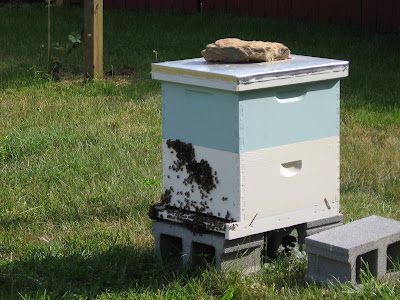I woke up at six this morning after dreaming about going into the hives and doing some work. I practiced in my sleep. I thought about it on my way home from church. I worked it all out in my head, step by step. I thought I would first move a hive, reaarange the concrete blocks and then put it back. We ditched that plan almost immediately after discovering how HEAVY the hives were. Huge concerns about the plan for double deeps, since they are so hard to heft. But...save that for later worry. For now, the hives sit right where they sat this morning, unbudged.

Went to step two, opening the hives, one at a time, cleaning off the tops of the frames and then taking the frames out, one by one to examine them. Did manage to get some of the bee goo off the top of the frames in each hive. Did manage to get some frames out and sort of look at them. The bees had moved onto the last frame in this first hive body (they started on only four or five of the nine frames). The picture below shows them building their comb on the last frame.

So here is where all planning went to hell. The smoker went out. The bees started flying about, whizzing around my head. The frames were covered in bees, and I squished some with the frame holders when pulling the frames out. I got a little panicked. The bees got a little cranky. I looked at frames in the right hive (the Sylvia hive) first....and got through about three frames before putting everything back and closing it up. In the second hive (the left, or Rachel hive) I moved more frames, got further into the hive....and then, in a cloud of cranky bees, put everything back and came inside.
*
Took a cold shower. Feel exhausted, but a little better. NO STINGS. There is always that.
*
(1)....need to practice with the smoker. Need to just get good at reliable smoke, when not in a hurry to get in the hive.
*
(2)....we put the next box of frames up. Bees now have room to expand, and if there is one thing I determined for sure, they are ready to expand the hive.
*
(3)...they still had sugar water left in their baggies. There was definitely a ring of honey around the tops of the frames that I looked at before losing my cool. Left the sugar water on top of the queen excluder on top of the upper deck, just in case they need a little extra boost while pulling out comb on this next level.
*
(4)....did not even pretend to look for the queen. We determined that there were a heck of a lot more bees in the hives, so somebody has been laying eggs.
*
(5)....did not determine if there were new eggs in the comb. I peeked at a couple frames pretty closely. I saw a billion bees, a lot of capped brood, and that nice ring of honey.
*
(6)....and then I just saw bees. Maybe that was perfectly normal bee activity and I just need further desensitization. Maybe when I get my technique down and feel less clumsy, all will go more smoothly and quietly. Maybe, as a new beekeeper, I need to just mark it as a success, take a breath, let the bees and myself regroup, and try again another day.
*
(7).....tomorrow night is a monthly bee class/club meeting. I'm definitely showing up. Need some coaching and moral support.
 On the bright side, Rachel is growing, full steam ahead. I went in, thinking I would add a queen excluder, and she had not only drawn out comb on the first shallow super, but it was chock full of bees. I ditched the queen excluder and just added another super. What the heck. Perhaps they'll keep the brood in the lower deeps. Perhaps I'll just wait and see what happens. Sometimes the queen will stay lower down below all the honey.
On the bright side, Rachel is growing, full steam ahead. I went in, thinking I would add a queen excluder, and she had not only drawn out comb on the first shallow super, but it was chock full of bees. I ditched the queen excluder and just added another super. What the heck. Perhaps they'll keep the brood in the lower deeps. Perhaps I'll just wait and see what happens. Sometimes the queen will stay lower down below all the honey.  Meanwhile, things still seem dire in Sylvia. She has started to pull out the comb in the upper deep, but down below we still saw no sign of brood, and perhaps a few too many drones. I'm reading up on combining a weak hive with a strong hive. Reading, reading, reading. I'll study up, give her another week and proceed from there.
Meanwhile, things still seem dire in Sylvia. She has started to pull out the comb in the upper deep, but down below we still saw no sign of brood, and perhaps a few too many drones. I'm reading up on combining a weak hive with a strong hive. Reading, reading, reading. I'll study up, give her another week and proceed from there. 


















